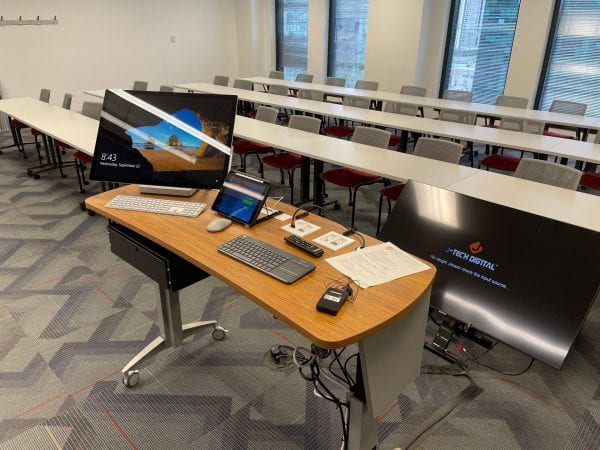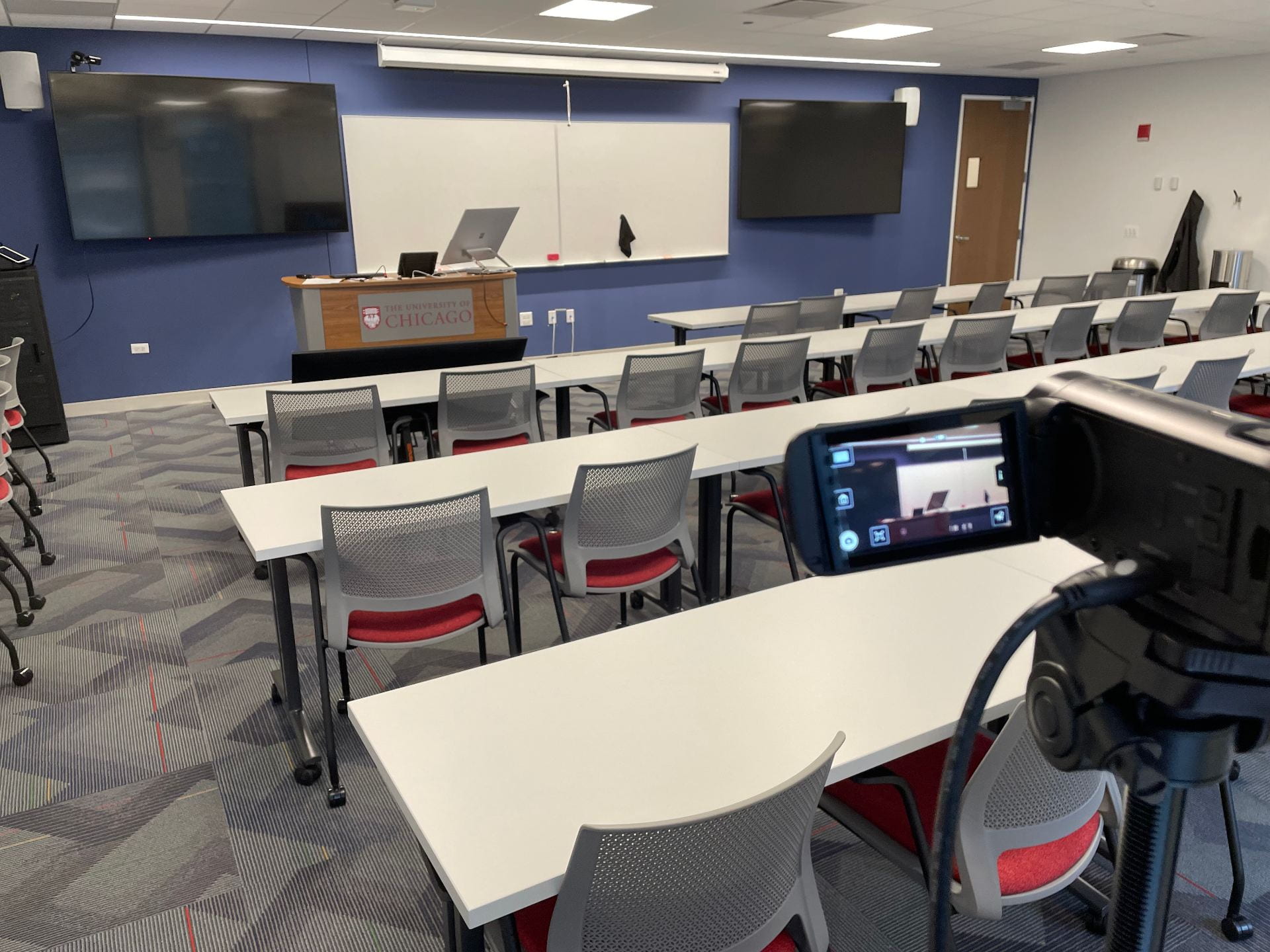The Autumn Quarter will primarily be offered in person, but from time to time students may be unable to come to class, for COVID-related reasons or otherwise. Over the last several months, UCPE ITS and Operations have been collaborating to outfit six classrooms in NBC Tower with improved audio and visual equipment so that students who cannot come to class can join remotely (or access high-quality recordings). While students will have the best educational experience in person, students whom instructors allow to join remotely can still have rich, interactive experiences.
Classrooms are outfitted such that the instructor can see the remote students on a large monitor in front of the podium; the remote students can see the in-person students and classroom space; everyone can see materials that the instructor shares; and the in-person and remote students and the instructor can hear each other. The main gap is that remote students won’t be able to easily hear in-person students when they talk. As such, for the best remote experience, instructors should repeat questions that the in-person students have so that they can be heard by the remote students and encourage separate discussions among remote and in-person studetns.
Members of UCPE’s IT and Operations team will be available to support instructors as they use this equipment. They will help instructors set up during the first week of class, be available for walk throughs and demos, and support in cases of emergency. To contact them, email ucpe-ops@uchicago.edu.

Upgraded lectern with 27 inch Surface Studio with touchscreen for digital whiteboarding, Zoom Room iPad, keyboards, HDMI input for instructor to plug in own laptop, lav microphone, and 55 inch floor monitor that displays to the instructor remote students

Two large monitors display materials that the instructor shares from their computer. This is seen by both students in the classroom and students who join remotely. Two 4k cameras display the instructor and classroom to remote students.
Using the Technology
Members of the operations team and IT team will help instructors teaching in these rooms get set up before their first class. Instructions are also provided below.
There are two main options for using the technology in the hybrid classrooms:
- Option 1. instructors can use the equipment that is provided
- Option 2. instructors can use their own computer.
Option 1 is highly recommended! The in-room equipment has already been tested and set up; if you bring your own equipment, be sure to budget ample time for set up and trouble shooting.
Option 1: Using the Equipment Provided
1. As shown in the image above, there will be a large Microsoft Surface Tablet that will function as your primary device. You will use it to host the Zoom meeting, share your slides, and whiteboard. Students who join remotely will see its screen, and its screen will also appear on two large monitors in the classroom.
- Use the web browser on the Surface Tablet to navigate to your Canvas site. Zoom meetings for your class will already be populated. Start the class’s Zoom meeting.
- Make sure that this computer is muted. It should be by default. Otherwise, there may be audio feedback from the various speakers and microphones in the room.
- You can copy any resources, such as slides, from your USB drive or download them from cloud storage to the Surface Tablet. You can also use a stylus to draw and annotate on the Surface Tablet.
2. There will be an iPad beside the Surface Tablet. This iPad is used to connect the cameras and microphones in the classroom. You will need to join the meeting from this iPad as well.
- Type in the meeting ID and password to join via iPad. Operations Staff should do this for you. In addition, a page with meeting IDs and passwords will be provided and stored within the lectern.
- If you choose to, you can use the controller on the iPad to adjust the volume on your microphone or select different cameras within the classroom.
3. Attach your wireless lav mic to your collar.
4. Use the Surface Tablet to whiteboard and display materials for the in-person and remote students.
Option 2: Bringing Your Own Device
1. If you bring your own device, make sure to budget ample time to test and debug!
2. Setting Up Your Device
- It is strongly recommended that you hard wire your device. An ethernet cable will be available on the lectern. Additional connectors can be requested from the Operations Team. Plug in the ethernet cable to your computer to ensure that you will have a fast, stable connection.
- Open your class’s Canvas site in your web browser. Start your class’s Zoom meeting from your computer.
3. There will be an iPad beside the Surface Tablet. This iPad is used to connect the cameras and microphones in the classroom. You will need to join the meeting from this iPad as well.
- Type in the meeting ID and password to join via iPad. Operations Staff should do this for you. In addition, a page with meeting IDs and passwords will be provided and stored within the lectern.
- If you choose to, you can use the controller on the iPad to adjust the volume on your microphone or select different cameras within the classroom.
4. Attach your wireless lav mic to your collar.
5. Use your own device to display slides and other materials that you would like the in-person and remote students to view.
Additional documentation for the iPad that controls Zoom:
https://support.zoom.us/hc/en-us/articles/360021921032-Zoom-Room-meeting-controls-and-settings#h_01EQCC03TCPRC72VKXZ7W47FDX